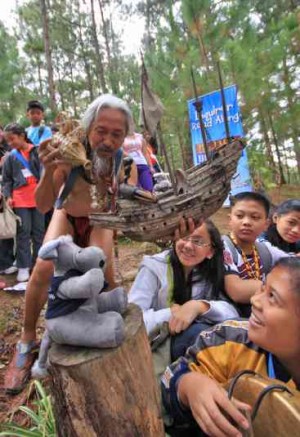Redeveloping Camp John Hay

CAMP JOHN HAY’S forest represents 50 percent of Baguio’s tree cover, and has served as an outdoor recreation site for various Baguio groups, like the Inquirer’s Read-Along session. EV ESPIRITU
The staggering amount of P1,588,855,553 was the winning bid tendered by the Manuela Lands and Housing Consortium on July 22, 1996 when the former American reservation Camp John Hay was leased out by the government—with Baguio City’s blessings.
About 240 hectares of built-up areas in John Hay were to become a tourism estate at a time when prime lands were at their peak.
But Manuela’s inexplicable withdrawal from the deal a month later might have been a first taste of how much trouble Camp John Hay, Baguio’s investment jewel, would become.
Penta Capital and the Fil Estate Management Corp., which offered the second highest bid of P425,001,378, inherited the project to develop the former base land, and formed the Camp John Hay Development Corp. (CJHDevco).
Eighteen years later, CJHDevco and the Bases Conversion and Development Authority (BCDA), the Camp John Hay administrator, are awaiting the results of arbitration proceedings ordered by a Baguio court, following a public spat over lease and the developer’s P3.4 billion outstanding rent debts.
Article continues after this advertisementRegardless of who the ruling would favor, BCDA would continue “bringing more business to John Hay,” said Jamie
Article continues after this advertisementAgbayani, president of the John Hay Management Corp., the BCDA estate manager of the John Hay Special Economic Zone.
A conceptual design for a “Camp John Hay 2.0” is due out in August for 40 ha of the estate that were not included in the areas leased to CJHDevco, she said.
It would explore the idea of redeveloping Camp John Hay into Baguio”s version of Central Park in New York City, Agbayani said, following a market study which shows that tourists return to Baguio for the cool weather and its remaining pine forests, 50 percent of which are inside the John Hay reservation.
First to be put on the auction block is Sheridan Drive, where JHMC is headquartered, and the Igorot Lodge, which has been leased to the Asian Institute of Management until 2018, Agbayani said.
A 3-ha property along Loakan Road is also being developed, she said.
But Baguio officials said they are not aware of these new plans. To them, Camp John Hay is about a feud of which city officials have not been involved.
BCDA president Arnel Paciano Casanova said he believed Baguio had played its role as mute bystander for far too long.
In a July 20 open letter published by a Baguio newspaper, Casanova said BCDA “has yet to hear the city fight for what rightfully belongs to its constituents,” after it filed one lawsuit after another against CJHDevco.
Challenge accepted
Baguio accepted Casanova’s challenge by again demanding an audit of Camp John Hay’s development.
Many old families also wanted to revisit the Camp John Hay master development plan that convinced Baguio to endorse its privatization.
“On hindsight,” said retired city architect Joseph Alabanza, “perhaps the fourth tender (P253,889,888 made by Ayala Land Inc.) approximated the kind of development we wanted for John Hay.”
Alabanza was Cordillera regional director of the National Economic and Development Authority (NEDA) when Camp John Hay was relinquished by the American military in 1991, shortly after the Senate rejected the extension of the Philippine-United States military bases agreement.
It soon became one of the government’s most attractive real estate properties, which concerned a city that was rebuilding from the Luzon earthquake in 1990.
The NGO Congress, an assembly of civic groups, nongovernment organizations and Baguio families, drew up a development framework for the summer capital, which discouraged high rises and promoted low density improvements.
Still attractive
Alabanza said that sentiment crossed over to the planning stages of the Camp John Hay lease.
Years earlier, city folk rallied to block the entry of the Tuntex Group of Taiwan, a foreign developer that intended to build a P2-billion theme park.
Conscious about the Anti-Tuntex Movement, a bloc of Baguio officials sought to regulate the density of buildings and other facilities to be built inside Camp John Hay, said lawyer Damaso Bangaoet Jr., former president of the John Hay Poro Point Development Corp (JPDC), the precursor of JHMC.
But Camp John Hay remains an attractive business venture.
Ayala Land Inc. had since returned to Camp John Hay as a JHSEZ locator to build the Ayala Baguio Technohub, which has increased revenues here.
Agbayani’s 2013 asset management report said Ayala helped raise the number of JHSEZ locators from 103 in 2012 to 110 last year, and the combined rental earnings that amounted to P25.7 million last year.
But Baguio remains suspicious. Early in July, Domogan directed the city legal office to determine whether BCDA had fulfilled its promises to Baguio, after observing that the city government had not received its 25 percent share from Ayala’s rent.